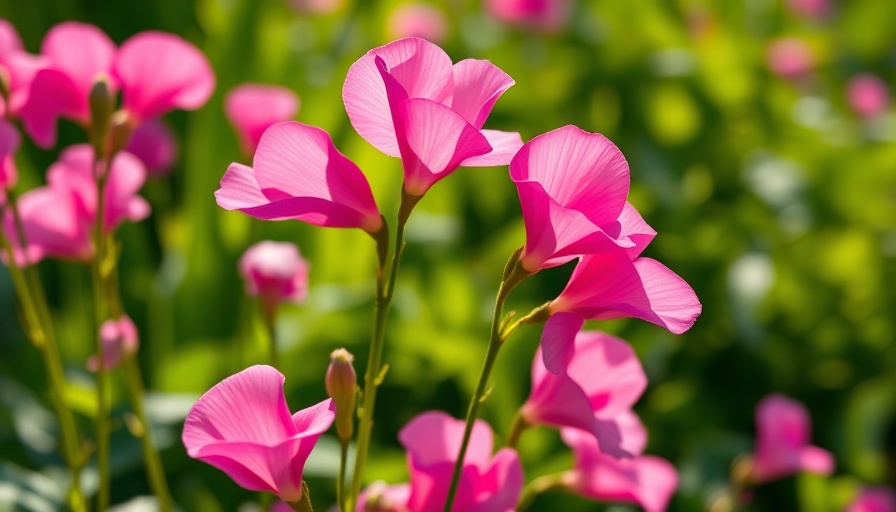
Unveiling the Beauty of Sweet Peas and Daisies This Spring
As the chill of winter recedes, spring bursts forth with vibrant colors and fragrant blooms. Among the most cherished flowers of this season are the sweet pea and the daisy, both embodying significant meanings that reflect joy and purity. These blossoms do more than just beautify our gardens; they symbolize profound emotions and mark significant milestones in our lives. Understanding their meanings and histories elevates their presence in our homes and gardens, allowing us to share soft messages of love and gratitude.
Symbolism You Can Savor: What Sweet Peas and Daisies Represent
Traditionally, sweet peas symbolize two distinct yet complementary meanings: joy and goodbye. Originating from southern Italy in the 1600s, these fragrant blossoms gained popularity in Victorian England. They became staples in bouquets, frequently gifted during farewells or as expressions of thanks after visits. Their light scent and gentle form remind us that goodbyes can carry sweetness, conveying gratitude and peace during transitions.
The daisy, with its bright white petals contrasted by a sunny center, conveys a message of innocence and new beginnings. Revered by ancient Romans for their supposed healing powers and linked by Celts to the spirits of children, daisies evoke purity and renewal. This makes them a fitting choice for celebrations of birth, love, and milestones in life.
Historical Roots Grounded in Cultural Significance
Both flowers hold deep cultural and historical significance. The sweet pea, lovingly woven into literature and art, speaks to the delicate nature of human emotions. Its association with farewell notes enriches its role in relationships, reminding us that endings are merely the precursors to new beginnings.
Daisies, on the other hand, celebrate the spirit of youth and new horizons. Their presence in ancient lore illustrates humanity’s age-old fascination with purity and renewal, making them timeless symbols tied to innocence and fresh starts.
Why Embracing These Flowers Matters This Spring
Incorporating sweet peas and daisies into spring celebrations—be it a birthday, wedding, or farewell gathering—offers a thoughtful way to express sentiments when words may not suffice. They allow us to share nuanced emotions, whether it's conveying joy in a new chapter or expressing heartfelt gratitude. By understanding their implications, we enrich our interactions and foster deeper connections.
Practical Tips for Cultivating These Charming Blooms
Growing sweet peas and daisies is not just rewarding but can also foster a sense of serenity in your garden space. Sweet peas thrive in well-drained soil with ample sunlight. Planting them in early spring ensures their vibrant colors and sweet fragrances fill the air by late spring. With support from trellises or fences, these climbing beauties create a stunning display while reminding us of the tender moments they symbolize.
For daisies, select a sunny spot in your garden. They're drought-resistant and thrive in a variety of soil conditions, making them perfect for gardeners of all levels. Regular deadheading will promote new blooms and extend their blossoming period through summer, embodying the spirit of renewal and growth.
Bringing Seasonal Beauty Indoors
These flowers can also transform your indoor spaces. Consider using sweet peas in a bouquet to surprise a friend or loved one, signaling your appreciation. Daisies can brighten your home with their cheerful appearance, amplifying an atmosphere of warmth and positivity. Both flowers serve as gentle reminders of the beauty surrounding us and the meaningful exchanges we can have with those we cherish.
Unlocking The Potential of Your Flower Garden
As homeowners and avid gardeners, embracing these blooms means more than just aesthetic appeal—it embodies a lifestyle choice that harmonizes with nature's rhythms. When we grow and nurture these flowers, we create spaces not just for beauty but for emotion; a true garden thrives on the human experience, intertwining our stories with the flora that comforts us.
Join the Spring Bloom Movement Today
This spring, cultivate a relationship with nature by incorporating sweet peas and daisies into your gardening endeavors. Use them as instruments of expression, reminders of purity, and symbols of joy in your life and those around you. Gardening is more than a hobby; it’s a means to connect with ourselves, our loved ones, and our communities.
So, why not take action today? Start planning your spring garden and consider adding these meaningful flowers. You may discover that the beauty of your garden reflects not just nature’s colors but the emotions you wish to convey.
 Add Row
Add Row  Add
Add 




Write A Comment